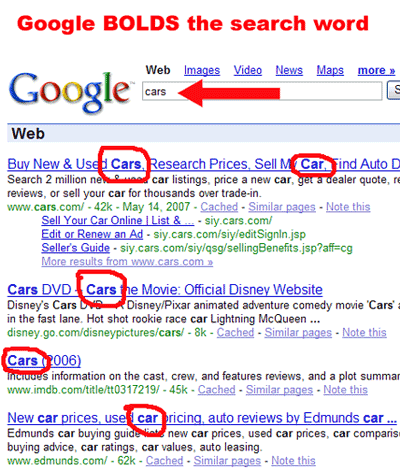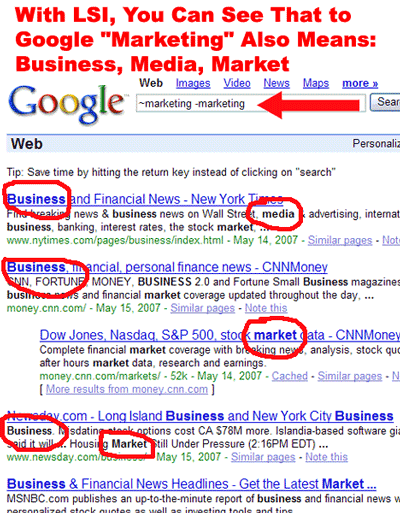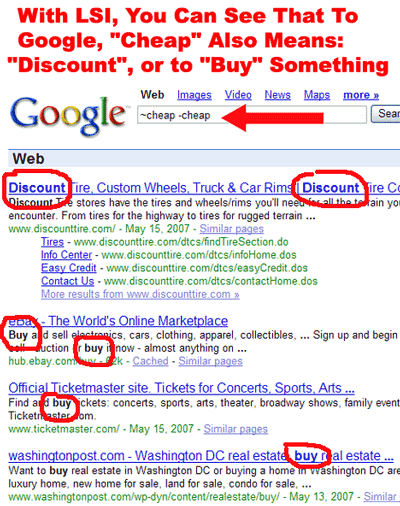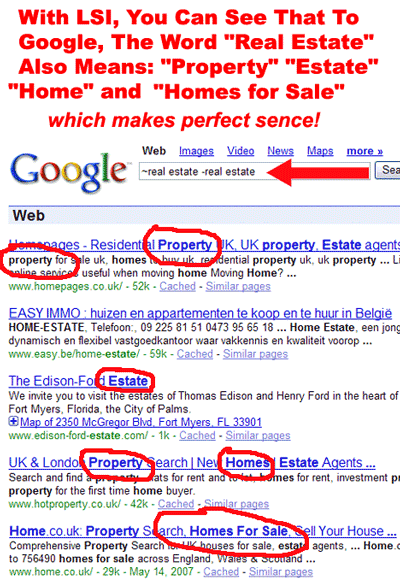Update: I originally wrote this post in 2007 (TUESDAY, MAY 15, 2007) on Google’s Blogger platform. I’ve recently moved it here as I have referenced it so many times and prefer it to be located here.
NEW YORK, NY – I have discussed LSI, Latent Semantic Indexing, in the past but I have never gone into it in great detail or provided real examples of the science in action so I want to go into it a bit right now. It is nothing short of amazing to see how one word can mean another to Google.
Understanding Latent Semantic Indexing and how it works can greatly help you to increase the overall visibility of your web site. When Google reads your site, having your most important keywords may not be enough. You may need to go just a bit further and make sure that your keywords AND your keywords related keywords are there as well.
Let’s look at a few examples of how some words have other meanings to Google under the Latent Semantic Indexing microscope.
If you have been using Google for a while, you may have already noticed that Google will bold out the keyword you’re searching for when it returns results on the Google search pages. We’ll use this bold feature to identify what words Google is using when returning results.
Example #1:
In the first example, you will see an ordinary search performed for the word “Cars”. Google returns a search page with the term being searched in Bold.

Example #2:
In Example two, we run a query using the LSI commands which is a ~ sign followed by the keyword in question and a – sign followed again by the keyword. This result will show you how Google believes that the word “marketing” has something to do with the words “Business” “Market” and “Media”. The science would be that if your main targeted keyword is “Marketing” than having these words on your website as well may be beneficial to your overall keyword density.

Example #3:
In Example three, we again run a query using the LSI commands which is a ~ sign followed by the keyword in question and a – sign followed again by the keyword. This result will show you how Google believes that the word “cheap” has something to do with the words “Discount” or to “Buy” something.

Example #4:
In Example four, we again run a query using the LSI commands which is a ~ sign followed by the keyword in question and a – sign followed again by the keyword. This result will show you how Google believes that the phrase “Real Estate” has something to do with the words “Property” or “Homes for Sale”. Pretty cleaver isn’t it?

Google uses these same techniques when it reads your web pages. So when using keywords on your web site, it may be very beneficial for you to not only cover your most targeted keywords, but some of those closely related terms that could give your overall LSI Keyword Density a high score.
Now taking LSI (Latent Semantic Indexing) into consideration, do you think you’re using all of the right keywords on your web site?
Create your perfect domain and host your website all with one account.

About The Author: John Colascione is Chief Executive Officer of Internet Marketing Services Inc. He specializes in Website Monetization, is a Google AdWords Certified Professional, authored a ‘how to’ book called ”Mastering Your Website‘, and is a key player in several Internet related businesses through his search engine strategy brand Searchen Networks®

 *** Here Is A List Of Some Of The Best Domain Name Resources Available ***
*** Here Is A List Of Some Of The Best Domain Name Resources Available ***
Leave a Reply